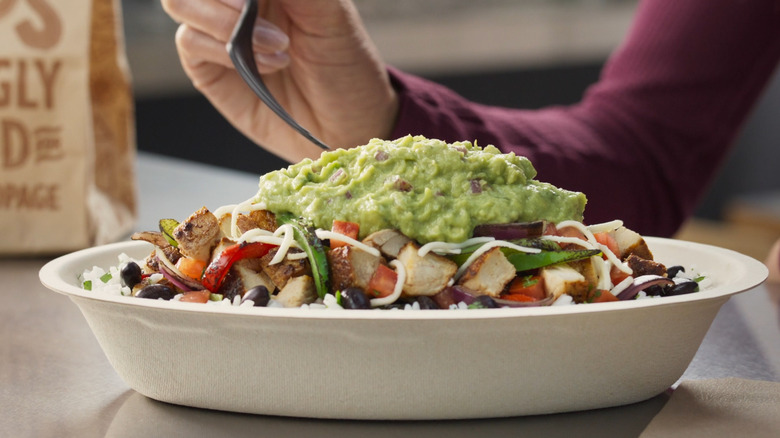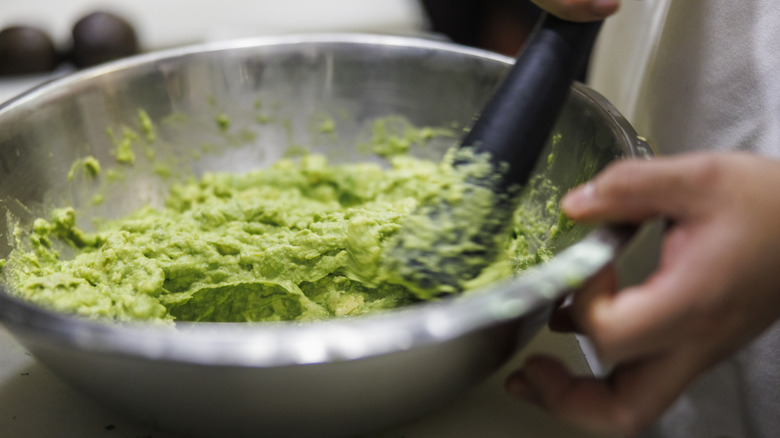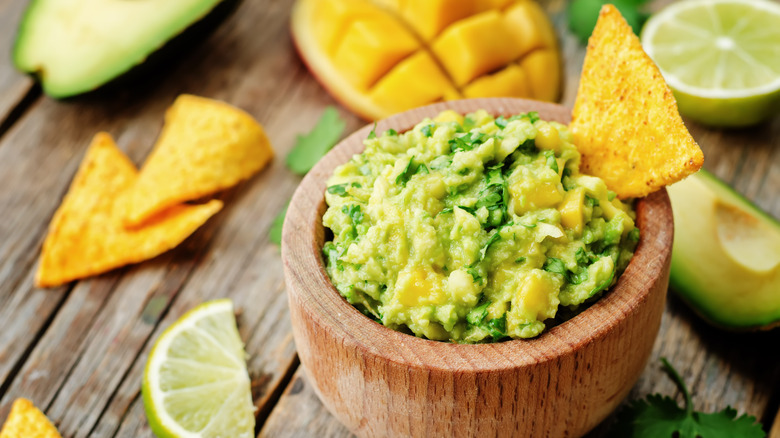Store Your Guacamole Like Chipotle And Thank Us Later
For such a near-universally beloved food, avocados sure do put us through our share of strife and woe. Choosing the perfect avocado at the store and learning how to ripen them can be challenging, not to mention the finicky task of dealing with your rock-hard orbs when you needed guac like yesterday, yet pouncing before they turn black. Then, once you achieve the holy grail that is a perfectly buttery, smooth, and pale green fruit, there's the sorrow of making a delicious guacamole and not being able to enjoy next-day leftovers, since it's gone muddy and dark in color. Regardless of what they put us through, the chase of perfect avocados and guacamole is one worth taking, as nothing hits like the smooth tang of this refreshing dip.
The next feather in your cap of avocado mastery is learning how to store your guacamole for optimal, fresh leftovers. The trick is to use a few layers of proper protection against the elements, plus refrigeration. Specifically, covering the guacamole tightly with plastic wrap, sealing it in a container with a lid, and then dunking it into an ice bath will ensure total freshness is preserved. A Chipotle representative told us via email that this triple-protection approach is pivotal for keeping the dip fresh until the next day. Your guac is no longer a one-time use situation and you can enjoy it for lunch tomorrow, too.
Cover with multiple protective layers to prevent air flow
If you've fallen into the habit of simply slapping some plastic wrap overtop a container of guac or closing it up with a food container lid, but you're still finding the spread turning dark, it's time to up your game and get serious about storing it — with not one, but two layers of coverage between the food and the air. Airtight storage is the end-all-be-all trick here, and while plastic wrap or a plastic container lid gets you part of the way there, both can still allow tiny amounts of air to get into the guacamole.
This air is what causes oxidation, aka the dreaded darkening of the avocado's once vibrant greenness. Pull out the big guns and cover the top of the container of guacamole tightly with plastic wrap, press it down onto the surface of the dip itself, and nestle the wrap around it firmly as though you're tucking it into bed. Then, place a well-fitting lid onto the container for double the protection. These methods help, but to be totally airtight, dunk the whole thing in a chilly ice bath, as they do at Chipotle. This keeps everything perfectly preserved and prevents any air from possibly sneaking in and ruining the party.
Prevent oxidation before it starts
The truth is, your leftover guac will still be good if you're scooping back into it hours after it's made, or even the next day, so long as you've stored it properly. But that doesn't mean it won't lose some of its visual appeal. As any guac lover knows, it's a common tragedy to open a storage tub of the green spread from the night before to find it browning. This is not, strictly speaking, a sign of rot — guacamole will keep its freshness in the fridge for a day or two, but no one wants to dip a chip into sludgy brown spread. So, the real thing we're after here with this tip is preventing browning, which can occur quite quickly (to a sliced avocado or a finished tub of guacamole) due to the perfectly natural process of oxidation.
This is not unique to 'cados, though. Oxidation occurs on the surface of a sliced apple or banana when it turns brown, and it's the visualization of a process of air interacting with the food's enzymes, creating melanin, the same pigment found in our hair and skin. Oxidized fruit isn't inherently bad or harmful to eat, but it's not exactly appetizing either. You can take steps to slow it down, like never using metal knives on your avocados. But it's best to store your guacamole as Chipotle would, for Taco Tuesdays that extend well into Wednesdays, and a dip that stays as vibrant as the day you made it.


